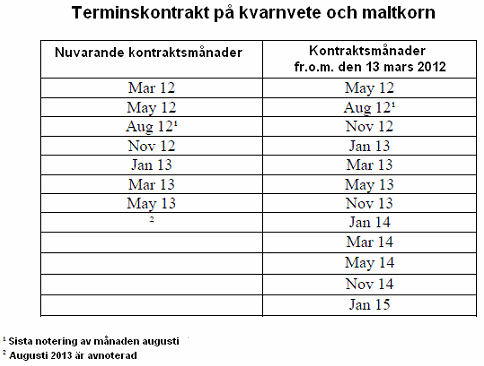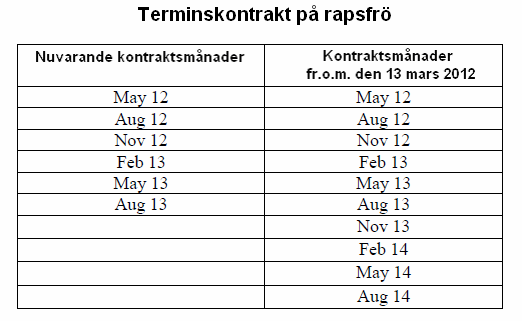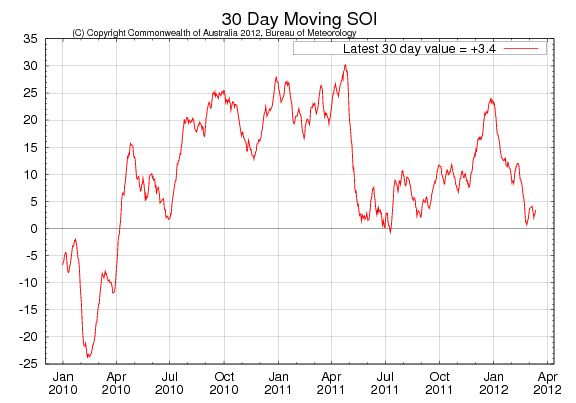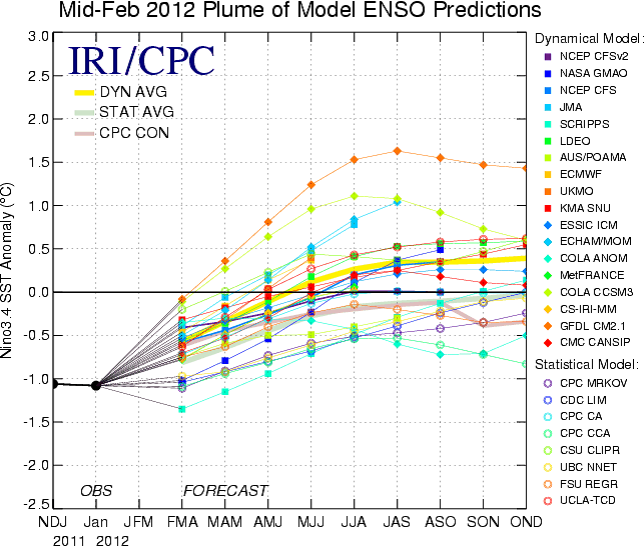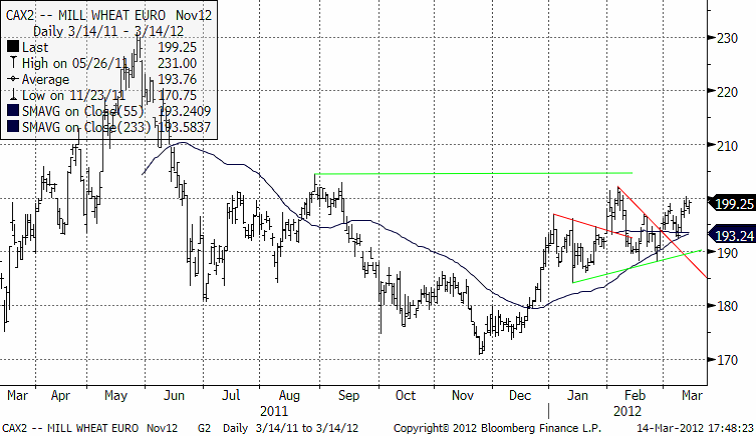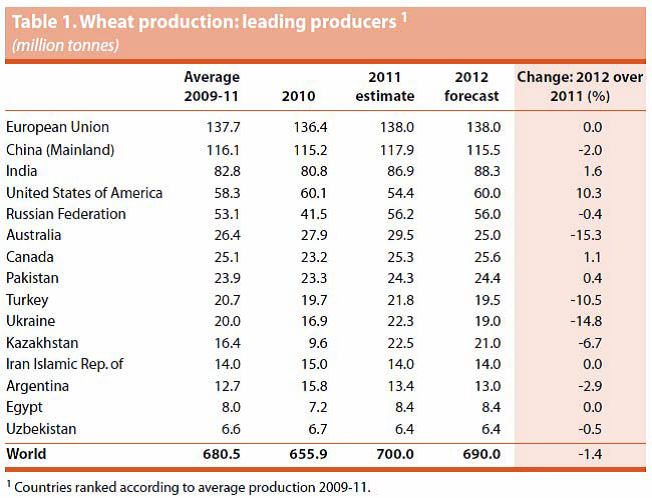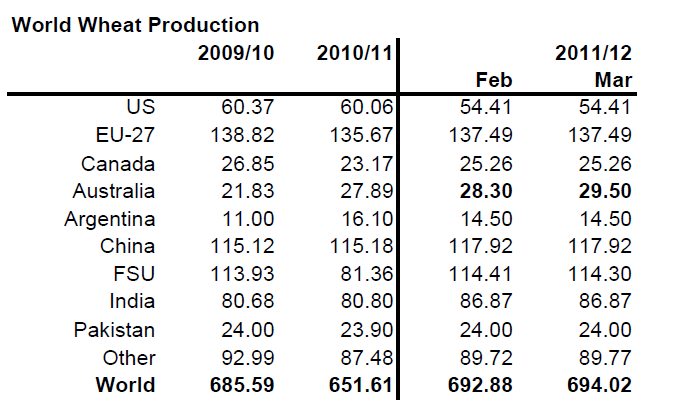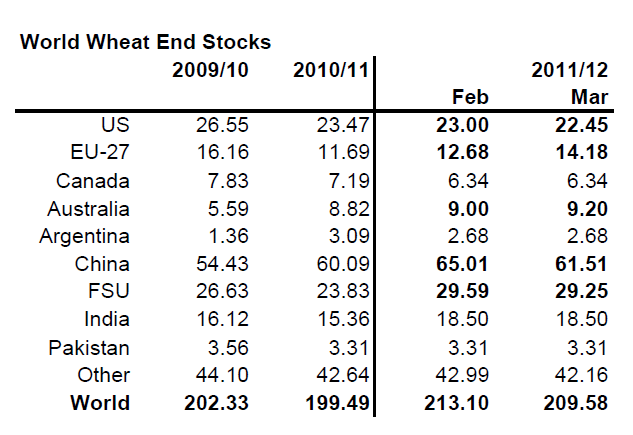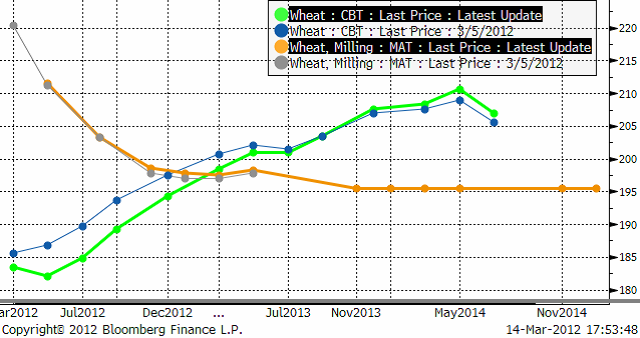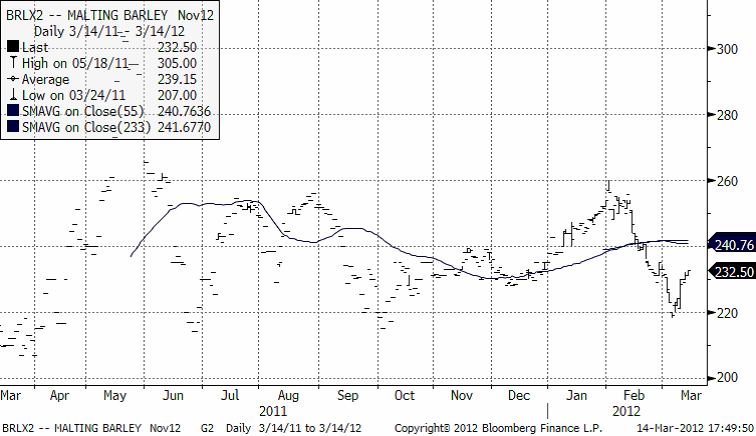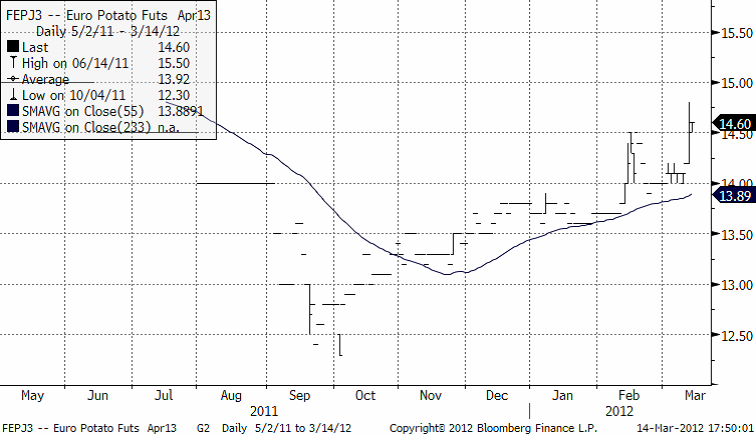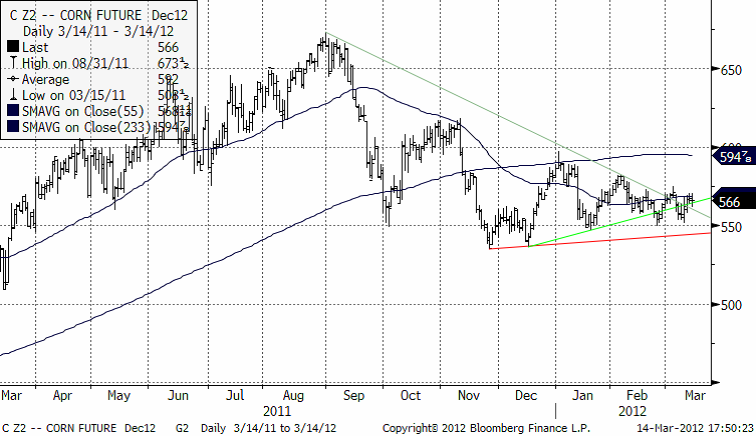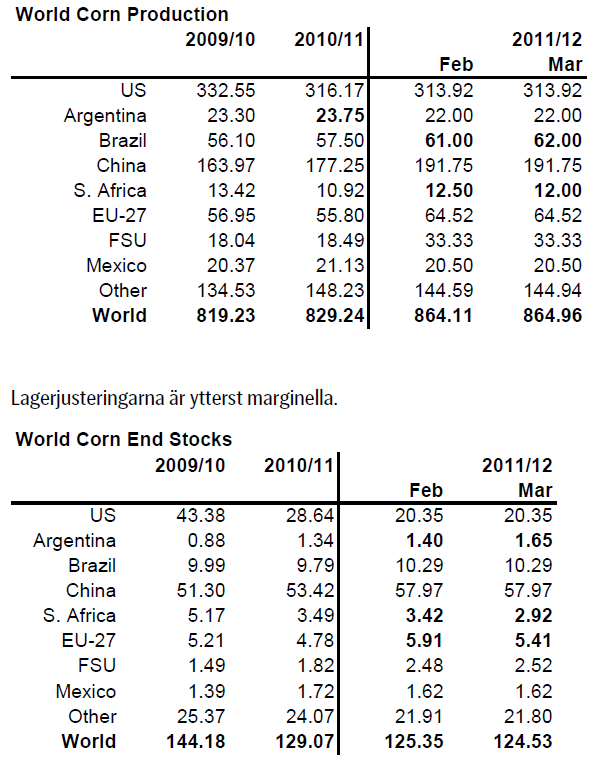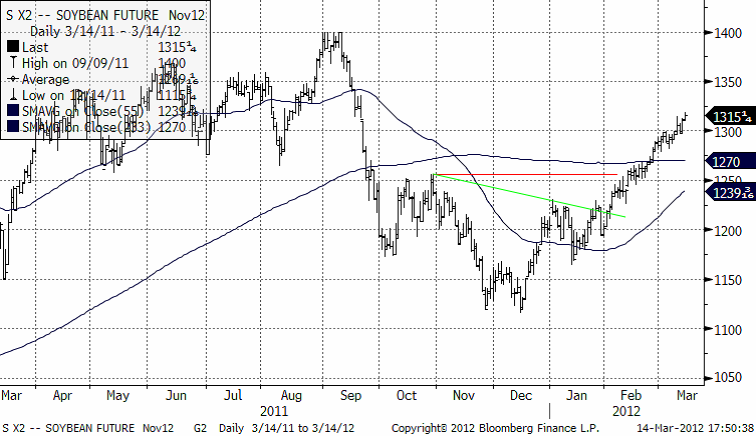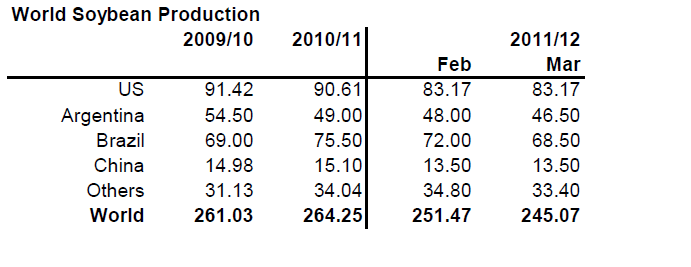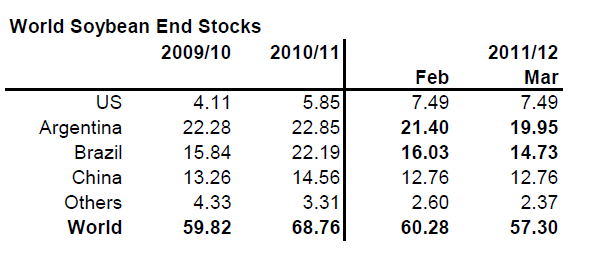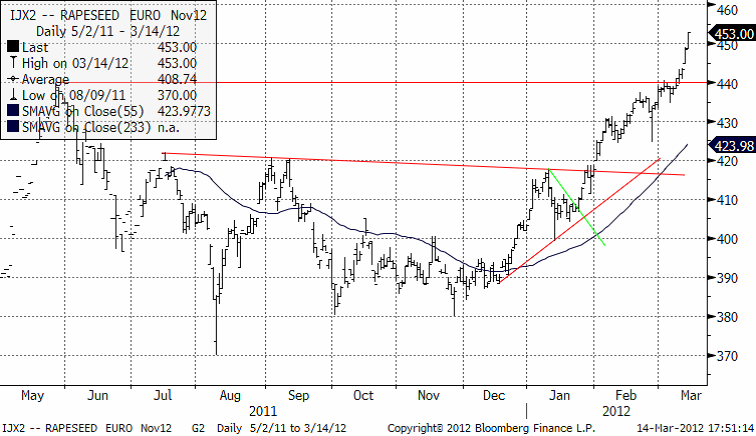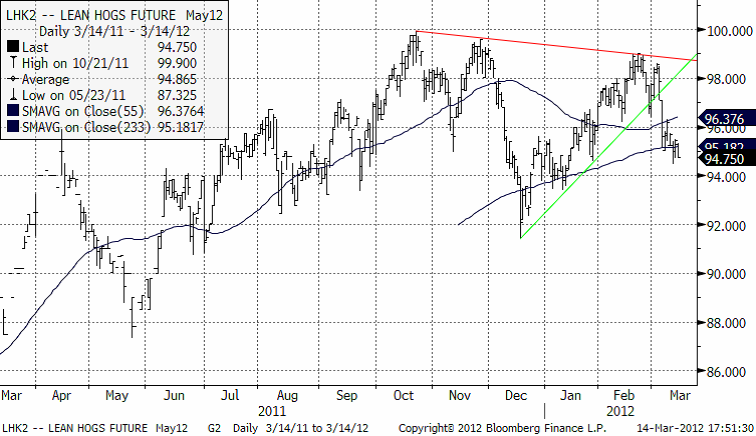Analys
SEB – Jordbruksprodukter, vecka 11 2012
 Den senaste veckan har priserna rört sig uppåt för några jordbruksprodukter och nedåt för andra. Raps och sojabönor tillhör vinnarna. WASDE-rapporten förra veckan gav den här typen av signal. För majs var rapporten totalt ointressant.
Den senaste veckan har priserna rört sig uppåt för några jordbruksprodukter och nedåt för andra. Raps och sojabönor tillhör vinnarna. WASDE-rapporten förra veckan gav den här typen av signal. För majs var rapporten totalt ointressant.
Nyhet! Förbättringar med fler kontrakt på Matif
Den europeiska börsen Euronext (Matif) har utökat antalet kontraktsmånader för terminer och optioner på kvarnvete, maltkorn, rapsfrö och majs med fr.o.m. tisdagen den 13 mars 2012. En annan förändring som sker är också att kontraktsmånaden augusti för kvarnvete och maltkorn kommer att försvinna. Augusti 2012 blir därmed den sista noterade augusti månaden för dessa två råvaror. För kvarnvete och maltkorn kommer antalet kontraktsmånader att utökas från nuvarande 8 till 12 enligt nedan:
För rapsfrö kommer antalet kontraktsmånader att utökas från nuvarande 6 till 10 enligt nedan:
Detta gör det möjligt att implementera en ”trappstegsstrategi” för att hantera prisvariation mellan odlingsåren och därmed avsevärt sänka intäktsvariationen på spannmåls- och oljeväxtodling mellan åren (utan att behöva använda Chicagovetekontrakten).
Odlingsväder
La Niña fortsätter att hålla sig kring noll. Även i veckan som gick rapporteras från Australiens meteorologiska byrå att ENSO-förhållandena är normala.
Nedan ser vi ensembleprognosen från amrikanska Climate Prediction Center. Den är gjord i mitten av februari, och den visade då att La Niña skulle klinga av och försvinna till neutrala ENSO-förhållanden till juni. Detta tycks nu, som vi sett, redan inträffat.
Vete
Novemberterminen på Matif testar återigen 200 euro per ton. Det finns så gott om motstånd på ovansidan att det är svårt att tänka sig att priset med lätthet skulle kunna gå uppåt. Statistiken är något ”bullish”, men inte överdrivet så. WASDE:n var något litet ”bullish”, medan senare FAO-statistik är något ”bearish”.
USA visade återigen sin konkurrenskraft på världsmarknaden efter att för tredje gången tagit hem anbudet från Egypten i förra veckan då GASC köpte ytterligare 60 000 ton amerikanskt vete. Priset på det amerikanska vetet låg klart under de priser som erbjöds från Kanada, Frankrike och Ukraina, även med de extra kostnaderna för frakt över Atlanten inräknat. [ USA; 259$/t + frakt 27.75$/t från Venus I Kanada; 267.75$/t från Louis Dreyfus I Frankrike; 286.89$/t från Cargill I Ukraina; 277.45$/t från Venus (exkluderad då den inte uppfyllde anbudets krav) ]
Den franska veteproduktionen kommer sannolikt att sjunka till 33.8 mt för 2011/12 från uppskattningsvis 35.7 mt under samma period året innan enligt France AgriMer, vilket också är något lägre än föregående månads prognos på 34 mt. De estimerar också att exporten av vete till ickeeuropeiska länder kommer att sjunka till 8.6 mt, en minskning från 12.9 mt under 2010/11, och exporten till europeiska länder kommer att falla till 6.5 mt jämfört med 6.7 mt förra säsongen. Tysklands produktion av vete (alla sorter) för 2012 förväntas öka med 6.3 procent till 24.2 mt jämfört med 22.7 mt under 2011.
Ukrainas regering justerar ned sin prognos för landets vete produktion för 2012 till 14 mt, från en tidigare förväntad produktion på nästan 16 mt, samtidigt som man betonar att de förväntade skördevolymerna kommer att täcka den inhemska efterfrågan på kvarnvete i Ukraina, vilket är i nivå med nästan 6 mt. Prognosen för landets spannmålsexport 2011/12 (juli-juni) justeras också ned med ca 20 procent, till 20-21 mt, till följd av att försäljningstakten har avtagit. Ukrainas premiärminister sa också att ”införande av någon form av kvoter (för spannmål) inte finns på agendan för 2012/13” och att landet kommer att ”få en genomsnittlig skörd som bör göra det möjligt för oss att lösa alla våra problem”.
Även analysföretagen UkrAgroConsult och ProAgro justerar också ned sina prognoser för Ukrainas vete produtkion till 13.8 mt resp 14.3 mt.
FAO’s första prognos över den globala vete produktionen för 2012 uppgår till 690 mt och blir därmed den näst högsta ur ett historiskt perspektiv. Jämfört med rekordåret 2011 är det en nedgång med 10 mt eller 1.4 procent men fortfarande en bra bit över genomsnittet för de senaste fem åren. Utsikterna för 2012 års globala vete produktion ser dock gynnsamma ut. Även om odlingen har ökat eller förväntas öka i många länder i år till följd av fortsatt starka priser, så förväntas en återgång till mer normala avkastningar i områden där rekordnivåer uppnåddes förra året. Men det är fortfarande tidigt att estimera den globala spannmålsproduktionen.
I Europa, förväntas arealen för vete att öka marginellt till strax över genomsnittet för de senaste fem åren och utifrån ett antagande om normala säsongsmässiga förhållanden för resten av perioden förväntas produktionen bli i stort sett oförändrar från 2011 års nivå på 138 mt.
I Ryssland rapporteras grödorna vara i gott skick med ett i allmänhet tilläckligt snötäcke som skyddat grödorna under en period av riktigt låga temperaturer, utom i vissa södra delar av landet. Sådden av höstvete har ökat markant jämfört med föregående år till följd av goda förutsättningar vid sådd. En viss ökning av vårvete väntas också. Under antagandet normala odlingsförhållanden för resten av säsongen, förväntas produktionen bli i stort sett oförändrad jämfört med förra årets relativt höga nivå på 56 mt.
I Ukraina däremot, är utsikterna för höstvete mindre gynnsamma med tanke på en minskad sådd till pga torkan i höstas och en ökad utvintring till följd av en period med kraftig kyla i kombination med begränsat snötäcke. Även om en viss del av bortfallet förväntas ersättas med vårvete, så uppskattas produktionen av vete i detta skede att falla från förra årets höga nivå.
I Nordamerika, visar tidiga indikationer på att veteproduktionen i USA pekar på en återhämtning på 10 procents jämförts med förra årets produktion som låg under genomsnittet. Årets produktion förväntas uppgå till 60 mt. Mars och april är den period då största delen av vetet i Kanada sås och arealen förväntas öka betydligt då lantbrukare åter sår en stor del av arealen som förra våren var för blöt för att kunna användas.
I Asien är utsikterna för veteproduktionen, där skörden börjar i april, i huvudsak gynnsamma för de flesta producerande länder. I Kina förväntas inga större förändringar i arealen, men produktionen kan komma att falla något, vilket skulle vara en återgång till en mer normal avkastning. I Indien och Pakistan väntas rekordskördar vilket bl.a. speglar en fullgod tillgång på vatten. I den asiatiska CIS är Kazakstan den största producenten och merparten av grödorna där sås i vår. Givet att ett stort överskott kvarstår sedan förra årets rekordskörd av vete, så förväntas årets vete areal att minska till förmån för andra grödor och därmed också en minskad produktion av vete.
I Mellanöstern rapporteras utsikterna för höstvete att vara goda och för Nordafrika är tidiga prognoser blandade. Utsikterna i Egypten är goda där grödorna till stor del är bevattnade och vattentillgången god medan det är värre för Marocko där sådden påverkades av det torra vädret och där betydande regn behövs snart för att förhindra ett betydande bortfall. På det södra halvklotet sker merparten av sådden av vete senare i år. I Australien, där sådden börjar i april, pekar tidiga indikationer på ytterligare en god skörd, även om den troligtvis inte når upp till 2011 års rekordskörd.
Precis efter förra veckans veckobrev publicerade USDA sin WASDE-rapport för mars månad. Den visade ingen förändring. Kicki trodde först att de skickat ut februaris siffror av misstag, därför att det var nästan ingenting som skiljde (vi tittar först och främst på USA:s siffror, eftersom det är det största exportlandet och det är export och importmarknaden som avgör världsmarknadspriset). Men totalt för vete blev det en liten uppjustering av väntad skörd globalt sett:
Ökad konsumtion framförallt i Kina (vi har tidigare nämnt wheat-for-feed), leder till lägre utgående globala lager.
Detta gav en liten skjuts uppåt på priset. Inte så mycket för Kinas konsumtion, som för att utgående lager i USA väntas bli lägre. För vetepriset såsom världsmarknadspris är det USA som i egenskap av största exportör, är den helt avgörande marknaden. Vi såg fallande priser på terminer med kort löptid i USA, medan terminskurvan i Europa är helt oförändrad de senaste sju börsdagarna:
Maltkorn
Novemberkontraktet på maltkorn rekylerade upp i veckan som gick.
Potatis
Priset på industripotatis för leverans nästa år steg ganska ordentligt i veckan som vi ser i nedanstående kursdiagram.
Majs
Majspriset har rört sig ovanligt lite den senaste veckan. WASDE-rapporten för en vecka sedan var likaledes ointressant.
USDA gjorde inga stora förändringar på hur mycket som man tror kommer att skördas i år. Man höjde skörden i Brasilien med 1 mt och sänkte Sydafrika med 500 kt. Vi noterar att man lämnat Argentina helt oförändrat från februaris rapport.
Om två veckor kommer lagerstatistikrapporten från USDA och den kanske blir något mer intressant.
Sojabönor
Novemberkontraktet gick efter en väldigt liten tvekan genom 13 dollar. Nästa motstånd finns på 1350 cent. Det är ovanligt med en så här pass lång och stadig trend uppåt, men när ska man gå emot?
WASDE-rapporten förra veckan visade lägre produktion av sojabönor. Globalt sänktes prognosen med 6.4 mt. Brasiliens skörd sänktes med 3.5 mt, Argentina 1.5 mt och Paraguay 1.4 mt. USDA:s skördeestimat ligger faktiskt lite lägre än vad Conab har.
Utgående lager sänktes 3 mt, främst i Argentina och Brasilien. Pga de redan låga utgående lagren i USA har man på USDA valt att inte sänka USA:s lager.
Raps
Den brittiska rapsexporten är fortsatt stark, och uppgår hittills för säsongen 2011/12 (juli-juni) till ca 500 000 ton, vilket redan överstiger de 435 311 ton som exporterades under 2011/11. Tyskland är den viktigaste marknaden för den brittiska rapsexporten och då Tysklands egen rapsskörd kollapsade med 30 procent pga av dåligt väder under 2011 så finns en fortsatt stark efterfrågan på import av raps som nu brittiska lantbrukare fortsätter att dra nytta av.
Dock förväntas Tysklands produktion av höstraps att öka under 2012 till 4.8 mt jämfört med 3.8 mt år 2011 enligt tidiga prognoser.
Vissa farhågor finns också hur den kraftiga kylan som har varit i Europa kommer att påverka rapsen. Det femåriga genomsnittet för EU’s rapsproduktion ligger på 19.5 mt och prognosen för 2012 från Europeiska kommissionen ligger nu på 20.2 mt. Andra privata analysfirmor uppskattar att produktionen kan bli så låg som 18 mt.
Europa står för ungefär en tredjedel av världens rapsproduktion, vilket innebär att bortfall i produktionen kan ha en stor inverkan på den internationella marknaden och vilket skulle ge ett visst indirekt stöd till den kanadensiska canolan. Även om inte Kanada exporterar mycket raps direkt till Europa, så skulle med stor sannolikhet exporten från Svartahavs-länderna och Australien till Europa öka och därmed skulle Kanada möta en minskad konkurrens på den asiatiska marknaden från dessa länder.
Nedan ser vi kursdiagrammet för novemberkontraktet. När 440 euro bröts fortsatte haussen under mycket kraftig handel. Det var säkert många som inte köpt tillbaka sålda kontrakt på 400 och det tvångsstängs antagligen en del kontrakt på en del konton nu.
Vi tycker att priset är högt, men marknaden är stark, och 440-nivån bröts. Därför har vi en neutral vy.
Gris
Majkontraktet som vi säljrekommenderade för en två veckor sedan har fortsatt att falla. Vi trodde för en vecka sedan att den kunde gå ner till 92, men kraften i nedgången har avtagit och om prisnedgången når 94 är det nog bra så.
[box]SEB Veckobrev Jordbruksprodukter är producerat av SEB Merchant Banking och publiceras i samarbete och med tillstånd på Råvarumarknaden.se[/box]
Disclaimer
The information in this document has been compiled by SEB Merchant Banking, a division within Skandinaviska Enskilda Banken AB (publ) (“SEB”).
Opinions contained in this report represent the bank’s present opinion only and are subject to change without notice. All information contained in this report has been compiled in good faith from sources believed to be reliable. However, no representation or warranty, expressed or implied, is made with respect to the completeness or accuracy of its contents and the information is not to be relied upon as authoritative. Anyone considering taking actions based upon the content of this document is urged to base his or her investment decisions upon such investigations as he or she deems necessary. This document is being provided as information only, and no specific actions are being solicited as a result of it; to the extent permitted by law, no liability whatsoever is accepted for any direct or consequential loss arising from use of this document or its contents.
About SEB
SEB is a public company incorporated in Stockholm, Sweden, with limited liability. It is a participant at major Nordic and other European Regulated Markets and Multilateral Trading Facilities (as well as some non-European equivalent markets) for trading in financial instruments, such as markets operated by NASDAQ OMX, NYSE Euronext, London Stock Exchange, Deutsche Börse, Swiss Exchanges, Turquoise and Chi-X. SEB is authorized and regulated by Finansinspektionen in Sweden; it is authorized and subject to limited regulation by the Financial Services Authority for the conduct of designated investment business in the UK, and is subject to the provisions of relevant regulators in all other jurisdictions where SEB conducts operations. SEB Merchant Banking. All rights reserved.
Analys
Brent crude set to dip its feet into the high $50ies/b this week

Parts of the Brent crude curve dipping into the high $50ies/b. Brent crude fell 2.3% over the week to Friday. It closed the week at $61.29/b, a slight gain on the day, but also traded to a low of $60.14/b that same day and just barely avoided trading into the $50ies/b. This morning it is risk-on in equities which seems to help industrial metals a little higher. But no such luck for oil. It is down 0.8% at $60.8/b. This week looks set for Brent crude to dip its feet in the $50ies/b. The Brent 3mth contract actually traded into the high $50ies/b on Friday.

The front-end backwardation has been on a weakening foot and is now about to fully disappear. The lowest point of the crude oil curve has also moved steadily lower and lower and its discount to the 5yr contract is now $6.8/b. A solid contango. The Brent 3mth contract did actually dip into the $50ies/b intraday on Friday when it traded to a low point of $59.93/b.
More weakness to come as lots of oil at sea comes to ports. Mid-East OPEC countries have boosted exports along with lower post summer consumption and higher production. The result is highly visibly in oil at sea which increased by 17 mb to 1,311 mb over the week to Sunday. Up 185 mb since mid-August. On its way to discharge at a port somewhere over the coming month or two.
Don’t forget that the oil market path ahead is all down to OPEC+. Remember that what is playing out in the oil market now is all by design by OPEC+. The group has decided that the unwind of the voluntary cuts is what it wants to do. In a combination of meeting demand from consumers as well as taking back market share. But we need to remember that how this plays out going forward is all at the mercy of what OPEC+ decides to do. It will halt the unwinding at some point. It will revert to cuts instead of unwind at some point.
A few months with Brent at $55/b and 40-50 US shale oil rigs kicked out may be what is needed. We think OPEC+ needs to see the exit of another 40-50 drilling rigs in the US shale oil patches to set US shale oil production on a path to of a 1 mb/d year on year decline Dec-25 to Dec-26. We are not there yet. But a 2-3 months period with Brent crude averaging $55/b would probably do it.
Oil on water increased 17 mb over the week to Sunday while oil in transit increased by 23 mb. So less oil was standing still. More was moving.

Crude oil floating storage (stationary more than 7 days). Down 11 mb over week to Sunday

The lowest point of the Brent crude oil curve versus the 5yr contract. Weakest so far this year.

Crude oil 1mth to 3mth time-spreads. Dubai held out strongly through summer, but then that center of strength fell apart in late September and has been leading weakness in crude curves lower since then.

Analys
Crude oil soon coming to a port near you

Rebounding along with most markets. But concerns over solidity of Gaza peace may also contribute. Brent crude fell 0.8% yesterday to $61.91/b and its lowest close since May this year. This morning it is bouncing up 0.9% to $62.5/b along with a softer USD amid positive sentiment with both equities and industrial metals moving higher. Concerns that the peace in Gaza may be less solid than what one might hope for also yields some support to Brent. Bets on tech stocks are rebounding, defying fears of trade war. Money moving back into markets. Gold continues upwards its strong trend and a softer dollar helps it higher today as well.

US crude & products probably rose 5.6 mb last week (API) versus a normal seasonal decline of 2.4 mb. The US API last night partial and thus indicative data for US oil inventories. Their data indicates that US crude stocks rose 7.4 mb last week, gasoline stocks rose 3.0 mb while Distillate stocks fell 4.8 mb. Altogether an increase in commercial crude and product stocks of 5.6 mb. Commercial US crude and product stocks normally decline by 2.4 mb this time of year. So seasonally adjusted the US inventories rose 8 mb last week according to the indicative numbers by the API. That is a lot. Also, the counter seasonal trend of rising stocks versus normally declining stocks this time of year looks on a solid pace of continuation. If the API is correct then total US crude and product stocks would stand 41 mb higher than one year ago and 6 mb higher than the 2015-19 average. And if we combine this with our knowledge of a sharp increase in production and exports by OPEC(+) and a large increase in oil at sea, then the current trend in US oil inventories looks set to continue. So higher stocks and lower crude oil prices until OPEC(+) switch to cuts. Actual US oil inventory data today at 18:00 CET.
US commercial crude and product stocks rising to 1293 mb in week 41 if last nights indicative numbers from API are correct.

Crude oil soon coming to a port near you. OPEC has lifted production sharply higher this autumn. At the same time demand for oil in the Middle-East has fallen as we have moved out of summer heat and crude oil burn for power for air-conditioning. The Middle-East oil producers have thus been able to lift exports higher on both accounts. Crude oil and condensates on water has shot up by 177 mb since mid-August. This oil is now on its way to ports around the world. And when they arrive, it will likely help to lift stocks onshore higher. That is probably when we will lose the last bit of front-end backwardation the the crude oil curves. That will help to drive the front-month Brent crude oil price down to the $60/b line and revisit the high $50ies/b. Then the eyes will be all back on OPEC+ when they meet in early November and then again in early December.
Crude oil and condensates at sea have moved straight up by 177 mb since mid-August as OPEC(+) has produced more, consumed less and exported more.

Analys
The Mid-East anchor dragging crude oil lower

When it starts to move lower it moves rather quickly. Gaza, China, IEA. Brent crude is down 2.1% today to $62/b after having traded as high as $66.58/b last Thursday and above $70/b in late September. The sell-off follows the truce/peace in Gaze, a flareup in US-China trade and yet another bearish oil outlook from the IEA.

A lasting peace in Gaze could drive crude oil at sea to onshore stocks. A lasting peace in Gaza would probably calm down the Houthis and thus allow more normal shipments of crude oil to sail through the Suez Canal, the Red Sea and out through the Bab-el-Mandeb Strait. Crude oil at sea has risen from 48 mb in April to now 91 mb versus a pre-Covid normal of about 50-60 mb. The rise to 91 mb is probably the result of crude sailing around Africa to be shot to pieces by the Houthis. If sailings were to normalize through the Suez Canal, then it could free up some 40 mb in transit at sea moving onshore into stocks.
The US-China trade conflict is of course bearish for demand if it continues.
Bearish IEA yet again. Getting closer to 2026. Credibility rises. We expect OPEC to cut end of 2025. The bearish monthly report from the IEA is what it is, but the closer we get to 2026, the more likely the IEA is of being ball-park right in its outlook. In its monthly report today the IEA estimates that the need for crude oil from OPEC in 2026 will be 25.4 mb/d versus production by the group in September of 29.1 mb/d. The group thus needs to do some serious cutting at the end of 2025 if it wants to keep the market balanced and avoid inventories from skyrocketing. Given that IEA is correct that is. We do however expect OPEC to implement cuts to avoid a large increase in inventories in Q1-26. The group will probably revert to cuts either at its early December meeting when they discuss production for January or in early January when they discuss production for February. The oil price will likely head yet lower until the group reverts to cuts.
Dubai: The Mid-East anchor dragging crude oil lower. Surplus emerging in Mid-East pricing. Crude oil prices held surprisingly strong all through the summer. A sign and a key source of that strength came from the strength in the front-end backwardation of the Dubai crude oil curve. It held out strong from mid-June and all until late September with an average 1-3mth time-spread premium of $1.8/b from mid-June to end of September. The 1-3mth time-spreads for Brent and WTI however were in steady deterioration from late June while their flat prices probably were held up by the strength coming from the Persian Gulf. Then in late September the strength in the Dubai curve suddenly collapsed. Since the start of October it has been weaker than both the Brent and the WTI curves. The Dubai 1-3mth time-spread now only stands at $0.25/b. The Middle East is now exporting more as it is producing more and also consuming less following elevated summer crude burn for power (Aircon) etc.
The only bear-element missing is a sudden and solid rise in OECD stocks. The only thing that is missing for the bear-case everyone have been waiting for is a solid, visible rise in OECD stocks in general and US oil stocks specifically. So watch out for US API indications tomorrow and official US oil inventories on Thursday.
No sign of any kind of fire-sale of oil from Saudi Arabia yet. To what we can see, Saudi Arabia is not at all struggling to sell its oil. It only lowered its Official Selling Prices (OSPs) to Asia marginally for November. A surplus market + Saudi determination to sell its oil to the market would normally lead to a sharp lowering of Saudi OSPs to Asia. Not yet at least and not for November.
The 5yr contract close to fixed at $68/b. Of importance with respect to how far down oil can/will go. When the oil market moves into a surplus then the spot price starts to trade in a large discount to the 5yr contract. Typically $10-15/b below the 5yr contract on average in bear-years (2009, 2015, 2016, 2020). But the 5yr contract is usually pulled lower as well thus making this approach a moving target. But the 5yr contract price has now been rock solidly been pegged to $68/b since 2022. And in the 2022 bull-year (Brent spot average $99/b), the 5yr contract only went to $72/b on average. If we assume that the same goes for the downside and that 2026 is a bear-year then the 5yr goes to $64/b while the spot is trading at a $10-15/b discount to that. That would imply an average spot price next year of $49-54/b. But that is if OPEC doesn’t revert to cuts and instead keeps production flowing. We think OPEC(+) will trim/cut production as needed into 2026 to prevent a huge build-up in global oil stocks and a crash in prices. But for now we are still heading lower. Into the $50ies/b.
-

 Nyheter4 veckor sedan
Nyheter4 veckor sedanOPEC+ missar produktionsmål, stöder oljepriserna
-

 Nyheter2 veckor sedan
Nyheter2 veckor sedanGoldman Sachs höjer prognosen för guld, tror priset når 4900 USD
-

 Nyheter3 veckor sedan
Nyheter3 veckor sedanBlykalla och amerikanska Oklo inleder ett samarbete
-

 Nyheter3 veckor sedan
Nyheter3 veckor sedanGuld nära 4000 USD och silver 50 USD, därför kan de fortsätta stiga
-

 Analys4 veckor sedan
Analys4 veckor sedanAre Ukraine’s attacks on Russian energy infrastructure working?
-

 Nyheter2 veckor sedan
Nyheter2 veckor sedanLeading Edge Materials är på rätt plats i rätt tid
-

 Nyheter3 veckor sedan
Nyheter3 veckor sedanEtt samtal om guld, olja, koppar och stål
-

 Nyheter2 veckor sedan
Nyheter2 veckor sedanNytt prisrekord, guld stiger över 4000 USD


